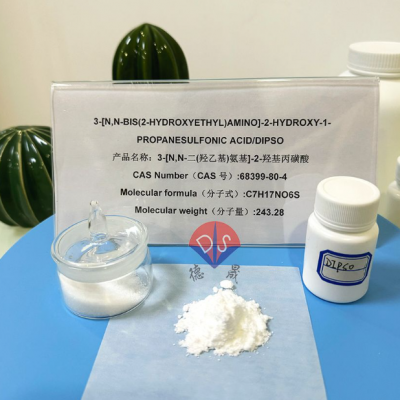Home > Products > Biological buffer > Biological Buffer DIPSO (68399-80-4) Detailed Description for Quick Understanding
Biological Buffer DIPSO (68399-80-4) Detailed Description for Quick Understanding
500 - 999 Kilograms
1000 - 4999 Kilograms
≥5000 Kilograms
- Shanghai
- T/T L/C PayPal Western Union
- 5 days
You May Like
-
Multiple Applications of CHES Buffer in Biological Research
-
Advantages of High TOOS Molar Absorbance
-
How to Obtain High-quality TOPS Powder as a Chromogenic Substrate
-
Stability and Storage Conditions of ADOS Products as Chromogenic Substrates
-
The Simplicity of ADPS Colorimetric Reagent in Experimental Operation
-
Packaging Requirements for Exporting Color Developing Substrate ALPS Powder in Small Batches
Product Details
| CAS No. | 68399-80-4 | Source | Concrete | |
| Application | Scientific Research | Usage | Laboratory Reagents, Analytical Reagents, Diagnostic Reagents | |
| Specific Usage | For Biological Purpose | Content | Other, 99 | |
| Habit Appellation | Other, DIPSO buffer | Property | Biochemical Reagent | |
| Classification | Biochemical Reagents | Grade | AR | |
| Transport Package | carton | Specification | 500g/bottle | |
| Trademark | DS | Origin | China |
Product Description
In the research fields of biochemistry and molecular biology, buffering agents can maintain the pH stability of reaction systems and provide a suitable environment for various biochemical reactions. As a unique biological buffer, understanding its characteristics, buffering performance, application fields, and limitations can help researchers accurately select and use DIPSO in experiments, fully leverage its advantages, and provide stable and reliable experimental conditions for biological research.
Basic characteristics of DIPSO
The Chinese name for DIPSO is 3- [N, N-di (hydroxyethyl) amino] -2-hydroxypropanesulfonic acid, also known as 3-bis (2-hydroxyethyl) amino-2-hydroxypropanesulfonic acid. From its molecular structure, it belongs to the dipole ion buffering agent and contains dihydroxyethylamine, which makes it biologically classified as a member of the bis (2-hydroxyethylamine) amine family of buffering agents.
DIPSO appears as a white crystalline powder, and its notable feature is that it is almost insoluble in organic solvents involved in biochemical reactions, and its solubility does not change with temperature. In an aqueous solution at 20 ℃, the saturation is 0.1M, and the colorless and transparent solution formed at this time is acidic.
The buffering performance of DIPSO
After dissolving DIPSO into a buffer solution, it can effectively adjust the pH of the solution within the range of 7.0-8.2. This pH range is suitable for many biochemical reactions and experiments, such as the activity determination of certain enzymes. Within this pH range, enzymes can maintain high activity, ensuring the accuracy of experimental results.
As a dipole ion buffer, DIPSO can resist external acid-base interference in solution through its own ionization equilibrium, thereby maintaining the stability of the solution pH. When acidic substances are added to the solution, the alkaline groups in DIPSO molecules will bind with hydrogen ions, inhibiting the decrease in pH value; When alkaline substances are added, their acidic groups release hydrogen ions, preventing an increase in pH.
Application areas of DIPSO
1. Protein Separation and Purification
In experiments using chromatography to separate and purify proteins, changes in pH can affect ionizable compounds, thereby interfering with the separation efficiency of proteins. DIPSO buffer can maintain the acidity and alkalinity of the system at a relatively constant value, effectively avoiding this interference. For example, in ion exchange chromatography, a stable pH environment facilitates specific binding and elution between proteins and ion exchange resins, thereby improving the purity and efficiency of protein separation.
2. Electrophoretic technique
Electrophoresis technology is one of the commonly used analytical methods in biochemistry and molecular biology. During electrophoresis, DIPSO buffer plays a crucial role. On the one hand, it can maintain the pH value of the solution unchanged when current passes through the experimental substance, ensuring the stability of the charged properties of biomolecules and thus ensuring the repeatability of their migration behavior in an electric field; On the other hand, DIPSO buffer also provides the necessary ions for migration in electrophoresis experiments, promoting the movement of biomolecules in an electric field and enabling effective separation of different biomolecules based on their charge and size characteristics.
Other precautions when using DIPSO
DIPSO can form complexes with various metals and precipitate, which makes it unsuitable for biological research environments that require metal ions. For example, in cell culture media that require metal cations, using DIPSO to stabilize the pH value can lead to the precipitation of metal ions, thereby affecting the normal growth and metabolism of cells. Although DIPSO has good buffering performance within a certain pH range, it cannot meet the requirements for experiments that require extremely strict pH values and exceed its effective buffering range. In certain biochemical reactions under extreme acidic or alkaline conditions, it is necessary to choose other more suitable buffering agents.
As a supplier of DIPSO buffer raw materials, Hubei Xindesheng Material Technology Co., Ltd. produces DIPSO buffer raw materials with high purity and extremely low impurity content, which can fully meet the strict requirements of scientific research and production. From raw material screening, to production process monitoring, to finished product testing, every step follows strict standards. Xindesheng not only provides high-quality products, but also has a professional technical support team to answer customers' questions and assist in solving various problems during the use of buffering agents at any time. If you have purchasing intentions, please feel free to contact us at any time!
Contact Us

- Hubei New Desheng Material Technology Co., Ltd
- Contact nameDoris Yang Chat Now
Product Categories
| Additive for blood collection | Biological buffer | Chemiluminescence reagent | Chromogenic substrate |
| enzyme preparation |
New Products
-
What Items Can DAOS, a Chromogenic Substrate, be Used to Detect?
-
Basic Information of the New Trinder's Reagent HDAOS Powder Reagent
-
Application of MADB 209518-16-1 in Serum Muscle Enzyme Detection Kit
-
Exploration of the Advantages of MAOS Chromogenic Substrates in Biochemical Detection
-
You Need to Pay Attention to These Three Erroneous Views When Purchasing Carbopol Powder
-
What is the Use of the New Trinder's Reagent TOOS 82692-93-1?
-
Application Introduction of TOPS Color Reagent (CAS40567-80-4)
-
What Applications Can the Chromogenic Substrate ADOS 82692-96-4 be Used In?
-
What Are the Advantages of Using ADPS 82611-88-9 as a Chromogenic Substrate?
-
Application of Color Reagent ALPS 82611-85-6 in Biochemical Experiments
-
Preparation and Use of New Trinder's Reagent DAOS 83777-30-4 Solution
-
Advantages of HDAOS 82692-88-4 as a Chromogenic Substrate in Desheng
-
What is the Function of the Chromogenic Substrate MADB 209518-16-1?
-
What Are the Advantages of the Chromogenic Substrate MAOS (CAS82692-97-5)?
-
The Role of TODB 127544-88-1 in Blood Lipid Testing Kit
-
Desheng Can Supply High-quality Luminol Raw Materials
-
Which is a Good Place to Buy Luminol Monosodium Salt (20666-12-0)
-
Chemiluminescent Reagent Isoluminol Factory Direct Sales
-
Luminescence Analysis of High-purity Acridine Ester NSP-DMAE-NHS 194357-64-7
-
Direct Chemiluminescence of Acridine Ester DMAE-NHS 115853-74-2
-
Detailed Introduction of Luminescent Reagent NSP-SA 211106-69-3
-
Precautions for Using Chemiluminescence Reagent Acridine Salt NSP-SA-NHS 199293-83-9
-
Detailed Introduction to Acridoyl Hydrazide NSP-SA-ADH
-
What Are the Functions of Luminescent Reagent Acridine Ester ME-DMAE-NHS?
Popular Searches
- naclo
- hypochlorite
- calcium salt
- lime plastering
- hypochlorite production
- swimming pool salt
- sea fish aquarium
- of calcium powder
- quotation sample
- aquarium coral
- emamectin benzoate wdg
- calcium price powder
- ptf
- aqua clear
- aquarium for sea water
- aquarium jellyfish
- aquarium white coral
- activator jean
- a coral
- accessories coral
- and coral
- ar mm
- ar outdoor
- ar or
- ar portable
- ar quality
- ar product
- ar price
- ar sale
- ar sony
Recommended Products
- Air and Environmental On-Site Testing Items Table
- Water Sample Mercury Ion (Hg²⁺) Concentration Assay Kit
- Nitrite Test Paper 0~100 Ppm
- On Site Rapid Detection of Surface Cleanliness of Catering Utensils
- Sodium Metasilicate Granular 25kg Powder
- Chlorine Dioxide Quick Test Kit
- Residual Chlorine Quick Test Kit
- Rapid Determination of Available Chlorine
- Quaternary Ammonium Sanitizer Concentration Test Strips [0~4000 Ppm]
- Quaternary Ammonium Sanitizer Concentration Test Strips [0~1000 Ppm]
- You Need to Pay Attention to These Three Erroneous Views When Purchasing Carbopol Powder
- Exploration of the Advantages of MAOS Chromogenic Substrates in Biochemical Detection
Find Similar Products By Category
- Chemicals > Chemical Reagent
- Please Enter your Email Address
- Please enter the content for your inquiry.
We will find the most reliable suppliers for you according to your description.
Send Now-
 Doris Yang
Hi there! Welcome to my shop. Let me know if you have any questions.
Doris Yang
Hi there! Welcome to my shop. Let me know if you have any questions.
Your message has exceeded the limit.

- Contact supplier for lowest price
- Customized Request
- Request Sample
- Request Free Catalogs
Your message has exceeded the limit.
-
Purchase Quantity
-
*Sourcing Details
Your inquiry content must be between 10 to 5000 characters.
-
*Email
Please enter Your valid email address.
-
Mobile





